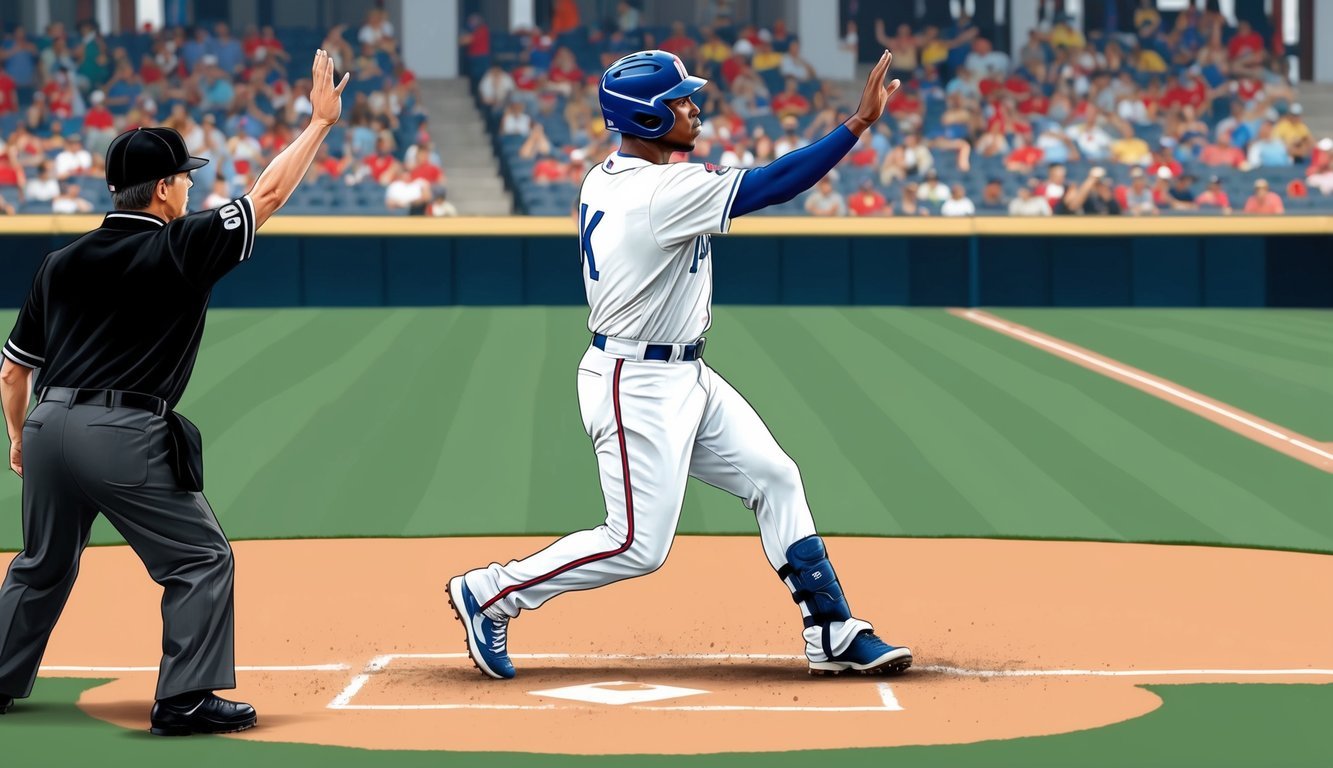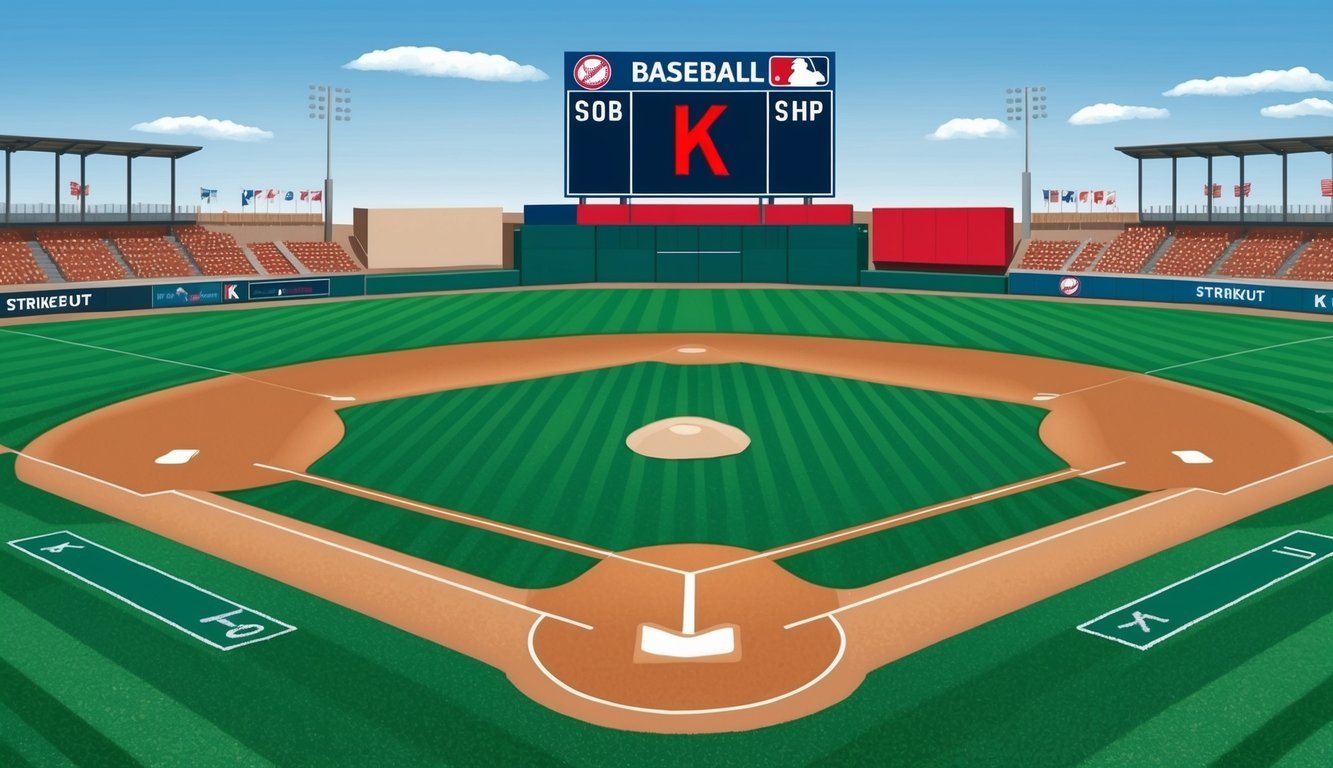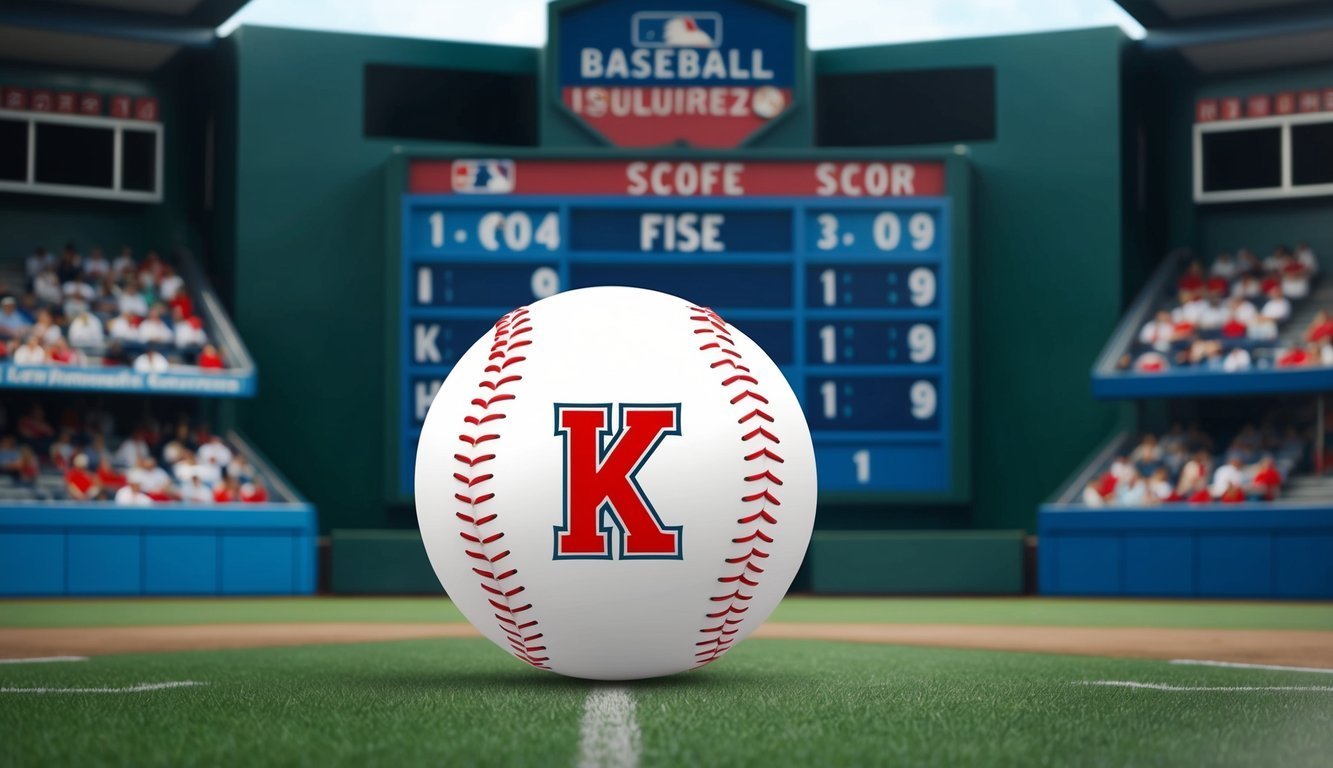Baseball has a unique language all its own, filled with colorful terms and statistics.
One of the most recognizable symbols in the sport is the letter “K” used to denote a strikeout.
The “K” in baseball stands for a strikeout, representing when a pitcher successfully retires a batter by throwing three strikes.
This simple yet powerful symbol has a rich history dating back to the 19th century.
Henry Chadwick, a pioneering baseball journalist and statistician, introduced the use of “K” to represent strikeouts in scorekeeping.
He chose this letter as it was the last consonant in “struck,” as in “struck out.”
The “K” has become an integral part of baseball culture, appearing on strikeout counters in stadiums and inspiring passionate fans to wave “K” signs when their team’s pitcher is racking up strikeouts.
It’s a testament to the enduring legacy of a single letter that has come to symbolize one of the most exciting moments in America’s pastime.
The Basics of a ‘K’ in Baseball
In baseball, the letter ‘K’ holds special significance as a symbol for a strikeout.
This simple yet powerful notation has become an integral part of the game’s scoring system and fan culture.
Understanding ‘K’ and Its Origins
The use of ‘K’ to represent a strikeout dates back to the 19th century.
Henry Chadwick, a pioneering baseball statistician, introduced this shorthand notation.
He chose ‘K’ because it was the last letter in “struck,” as batters were said to be “struck out.” The letter’s visual simplicity also made it easy to record quickly during fast-paced games.
Over time, ‘K’ has become deeply ingrained in baseball culture.
Fans often display ‘K’ signs at stadiums to celebrate their team’s pitchers racking up strikeouts.
This tradition has helped solidify the ‘K’ as an iconic symbol in the sport.
Decoding ‘K’ in Scoring: Strikeout Types
Scorekeepers use variations of ‘K’ to denote different types of strikeouts:
- Forward ‘K’: Represents a strikeout where the batter doesn’t swing at the third strike
- Backward ‘K’: Indicates a called third strike where the batter doesn’t swing
These distinctions help provide a more detailed picture of how strikeouts occur during a game.
Pitchers and coaches can use this information to analyze their strategies and performance.
The Role of Pitchers and Batters in a Strikeout
A strikeout involves a battle between the pitcher and batter.
The pitcher aims to throw three strikes before allowing four balls or a hit.
Strikes can be:
- Swinging strikes (batter swings and misses)
- Called strikes (pitch in the strike zone not swung at)
- Foul balls (count as strikes, except on the potential third strike)
Batters work to avoid strikeouts by making contact with the ball or drawing walks.
Skilled batters often “foul off” tough pitches to stay alive in the count.
This dynamic creates tension and excitement in every at-bat, with the ‘K’ serving as the ultimate goal for pitchers and the outcome batters strive to avoid.
Strikeout Statistics and Records
Strikeouts play a crucial role in baseball, impacting both pitchers’ and batters’ performances.
They serve as a key metric for evaluating player skills and have led to some impressive records in MLB history.
Importance of Strikeouts in Player Statistics
Strikeouts, often denoted by “K,” are a vital statistic for pitchers.
A high strikeout rate indicates a pitcher’s ability to dominate batters.
The K/9 (strikeouts per nine innings) stat helps compare pitchers across different eras.
For batters, strikeouts are generally seen as negative.
A low strikeout rate often correlates with better contact and on-base skills.
However, some power hitters have successful careers despite high strikeout totals.
Teams and scouts closely monitor strikeout trends.
The rise of analytics has led to increased focus on strikeout rates when evaluating players for contracts and trades.
Significant MLB Strikeout Records
Nolan Ryan holds the all-time career strikeout record with 5,714 Ks.
Known as the “Ryan Express,” he led the league in strikeouts 11 times during his 27-year career.
Most single-season strikeouts by a pitcher:
- Matt Kilroy (1886) – 513
- Toad Ramsey (1886) – 499
- Hugh Daily (1884) – 483
In the modern era, Gerrit Cole’s 326 strikeouts in 2019 stands out.
For batters, Reggie Jackson holds the career strikeout record with 2,597.
Mark Reynolds set the single-season mark with 223 in 2009.
The Baseball Hall of Fame recognizes these strikeout milestones, highlighting their significance in the sport’s history.
Analyzing Strikeouts in Gameplay

Strikeouts play a crucial role in baseball, influencing the outcome of at-bats and entire games.
They showcase the battle between pitchers and batters, often determined by skill, strategy, and split-second decisions.
Different Outcomes of a ‘K’
Strikeouts come in two main forms: swinging and looking.
A swinging strikeout occurs when a batter misses the ball on the third strike.
A looking strikeout happens when the batter doesn’t swing at a pitch called a strike by the umpire.
Both types of strikeouts result in an out, but they can affect the game differently.
Swinging strikeouts may indicate aggressive batting, while looking strikeouts might suggest a batter caught off-guard or fooled by a pitcher’s skill.
Strikeouts can also lead to other outcomes.
With less than two outs and first base open, a dropped third strike allows the batter to attempt reaching first base safely.
Strategy Behind Swinging vs. Looking Strikeouts
Batters often face tough decisions at the plate.
They must choose whether to swing or hold back, especially with two strikes.
This choice can make the difference between a strikeout and a potential hit or even a home run.
Some batters adopt a protective approach with two strikes, fouling off pitches to stay alive.
Others might look for a specific pitch to drive, risking a looking strikeout if they guess wrong.
While the strategies can vary, both approaches reflect a deep understanding of the game and the type of pitcher they face.
In certain situations, the infield fly rule explained helps batters make more informed decisions, as they understand how the rule can influence their risk-taking at the plate.
Ultimately, whether they choose to battle off pitches or hunt for a perfect delivery, every decision is crucial in determining the outcome of the at-bat.
Pitchers, in turn, try to exploit batter tendencies.
They might throw a fastball when the batter expects a breaking ball, or vice versa.
This mental game adds excitement to every at-bat.
How Pitchers Achieve a Strikeout
Pitchers use various techniques to strike out batters.
They rely on a mix of velocity, movement, and deception to keep hitters off-balance.
A blazing fastball can overpower batters, especially when located well.
Breaking balls like curveballs and sliders can fool hitters with their movement.
Change-ups disrupt a batter’s timing by mimicking a fastball’s arm speed but arriving much slower.
Pitchers also sequence their pitches strategically.
They might set up a strikeout by throwing fastballs early in the count, then finishing with a breaking ball.
Or they could reverse this pattern to keep batters guessing.
Location matters too.
Pitches on the corners or just out of the strike zone can entice batters to swing and miss or take a called third strike.
Scoring Systems and Strikeout Notations

Baseball scoring uses a variety of symbols and abbreviations to record game events efficiently.
The letter “K” holds a special place in this system, representing strikeouts.
From Scorecards to Digital: Recording Ks
Scorekeepers have used scorecards to track baseball games for over a century.
These cards feature a grid where each cell represents a player’s at-bat.
When a batter strikes out, the scorekeeper marks a “K” in the corresponding cell.
Modern digital systems have largely replaced paper scorecards, but they still use the same notation.
Box scores, which summarize game statistics, also employ the “K” symbol to tally strikeouts.
Other common abbreviations in scoring include “E” for errors, “HR” for home runs, and “DP” for double plays.
These shorthand notations allow scorekeepers to quickly record complex game events in limited space.
Understanding Forward Vs. Backward Ks
Not all Ks are created equal in baseball scoring.
A forward-facing “K” indicates a swinging strikeout, where the batter swung and missed on the third strike.
A backward “K” (�strikeout looking) signifies that the batter took the third strike without swinging.
This distinction helps fans and analysts understand how batters are being retired.
Pitchers often aim for swinging strikeouts, as they demonstrate the effectiveness of their pitches in fooling batters.
However, a backward K can showcase a pitcher’s command and ability to hit the strike zone precisely.
Cultural Impact and Iconic Moments

The “K” symbol has become deeply ingrained in baseball culture, sparking fan engagement and memorializing legendary pitching performances.
Its influence extends beyond the scoreboard to shape the way fans and players talk about the game.
Strikeouts in Baseball Culture and Lingo
Baseball fans have embraced the “K” symbol with enthusiasm.
Many stadiums feature “K boards” where fans hang large K-shaped placards to track strikeouts by the home team’s pitcher.
This tradition creates a visual spectacle and fosters a sense of community among spectators.
The term has also seeped into baseball lingo.
Phrases like “Struck him out!” or “He went down on strikes” are commonplace.
Fans often chant “K” when an opposing batter has two strikes, adding to the game’s atmosphere.
Baseball video games and fantasy leagues frequently use “K” in their interfaces, further cementing its place in the sport’s vocabulary.
Memorable Strikeouts in Baseball History
Certain strikeouts have become iconic moments in baseball history.
Dwight Gooden’s 1984 season with the New York Mets stands out.
He racked up an astonishing 276 strikeouts, earning him the nickname “Dr. K.”
Nolan Ryan, enshrined in the Baseball Hall of Fame, holds the all-time strikeout record with 5,714 Ks.
His seven no-hitters often featured double-digit strikeout performances.
In the 2001 World Series, Randy Johnson and Curt Schilling combined for 45 strikeouts, leading the Arizona Diamondbacks to victory.
Their dominant performances are still celebrated by fans today.
